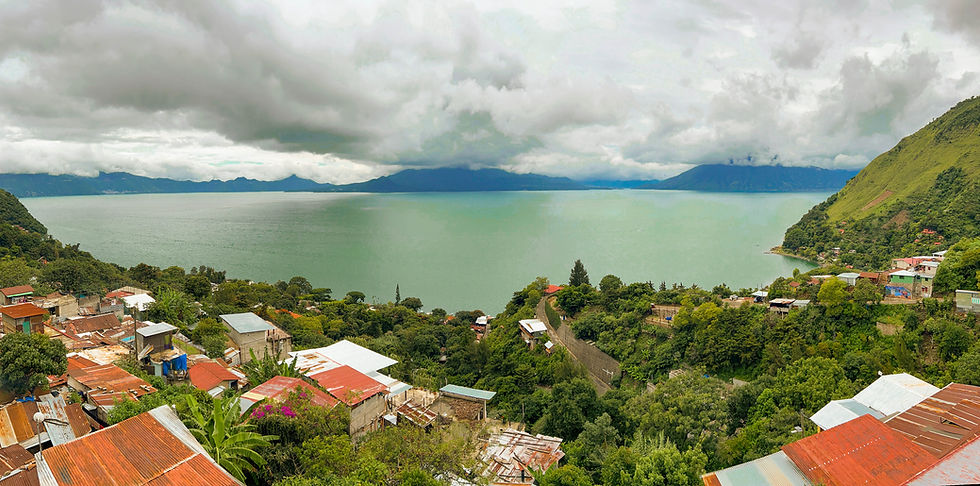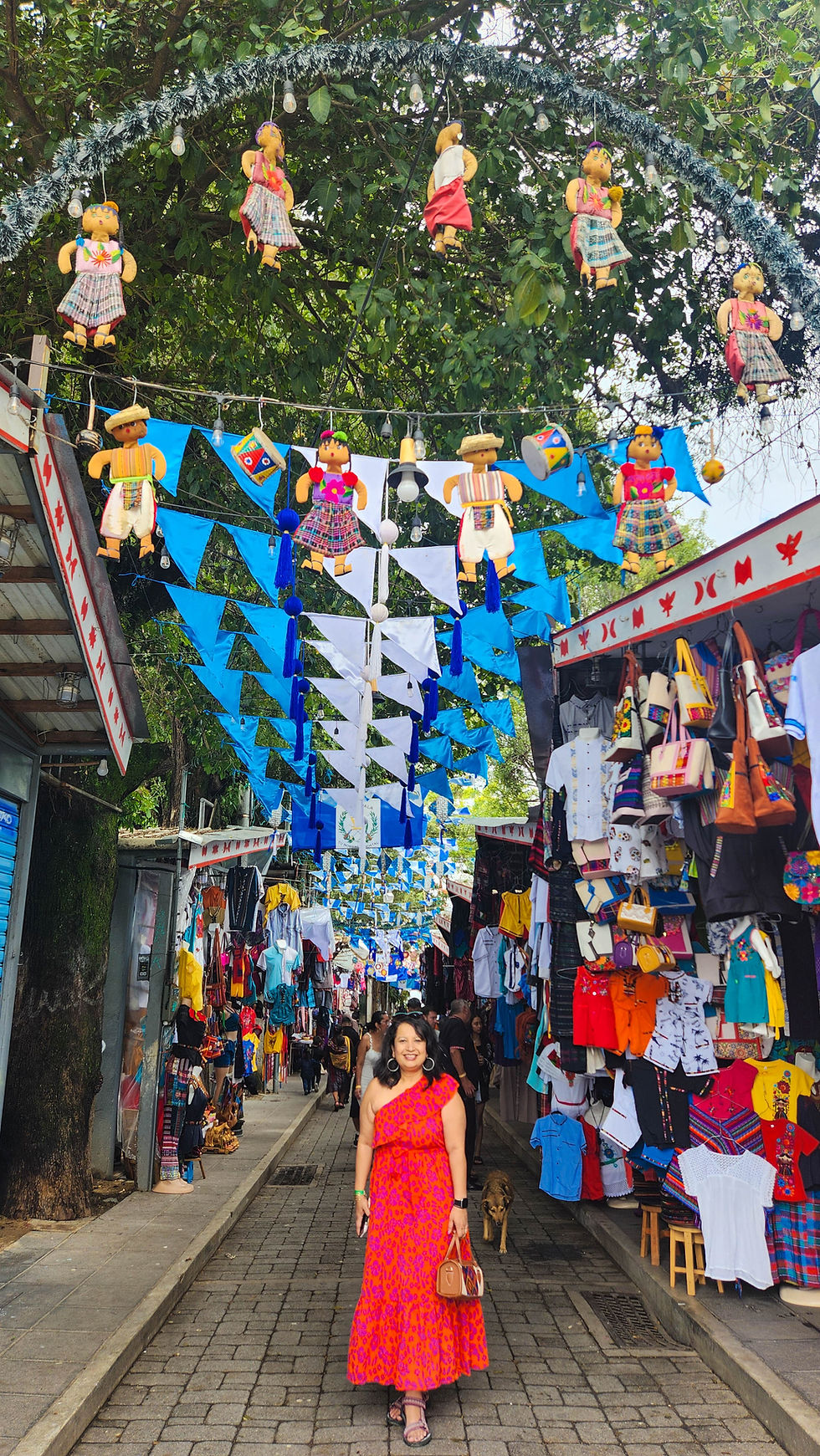From Atitlan to Antigua - A 5 day Guatemala Adventure
- solarastills
- 19 hours ago
- 12 min read

Tucked between volcanoes, lakes, and ancient ruins, Guatemala is a country that surprises you slowly. One moment you’re sipping coffee in a colonial courtyard, the next you’re hiking through cloud forests or drifting across Lake Atitlán. It’s not on every traveler’s radar, but maybe that’s the point. Guatemala keeps its magic close, waiting for those who take the time to look.
Over five days, we followed winding roads, climbed into highlands, and drifted across lakes. We ate, walked, watched, and listened. Each stop gave us new stories. This itinerary is what worked for us: a mix of places, people, and moments that felt right. If you're planning a trip to this magical and colorful country, here’s how we spent our time.

Why Guatemala?
Guatemala is closer than you think. It is just a quick flight from the Bay Area with a stop in Houston, and soon you’re stepping into a world of volcanoes, lakes, and ancient cities. While travel advisories might raise eyebrows, our experience was smooth and safe, even during evening walks through bustling town centers. The warmth of the people, the ease of getting around, and the sheer variety of things to see made it feel welcoming from the start. If you’re looking for a destination that’s rich in culture and surprisingly accessible, Guatemala is worth the leap.
Best Time To Go
The best time to visit Guatemala is during the dry season, which runs from November to April. Skies are clear, roads are easier to navigate, and outdoor adventures - from hiking volcanoes to exploring Mayan ruins - are more enjoyable without the rain. If you're aiming for fewer crowds and lower prices, the shoulder months of November and early May can be a sweet spot. We visited in September, during the rainy season. Although it rained a couple of hours each afternoon, after two pm, it didn't disrupt our plans and travels, and we thoroughly enjoyed the minimal number of tourists everywhere we went.
Safety
Despite the cautionary tales often associated with Central America, we found Guatemala to be surprisingly safe and welcoming. We roamed the streets freely, even after dark, and never felt uneasy. In fact, one night in Antigua, when hubby was under the weather, I ventured out solo and strolled through the cobblestone lanes surrounded by colonial charm and twinkling lights, feeling perfectly at ease. Locals were friendly, and the atmosphere was relaxed, making it easy to enjoy the vibrant culture without worry.
Currency
The quetzal, named after Guatemala’s national bird, is a vibrant symbol of the country’s heritage, since its tail feathers were once used as currency in ancient Mayan culture. For US travelers, the exchange rate is quite favorable: $1 USD gets you around 7.66 GTQ (as of October 2025), making everyday expenses like meals, transportation, and souvenirs relatively affordable. ATMs are widely available throughout the country, including in airports, hotels, and even small towns, which made accessing cash incredibly convenient during our trip. We relied on ATMs for all our withdrawals, and most machines accepted international debit cards without issue. Just be sure to notify your bank before traveling and check for any foreign transaction fees. International credit cards are generally accepted, though street vendors typically do not accept them. US dollars are not accepted at most locations.
Transportation
Getting around Guatemala is an adventure in itself, with a mix of modern convenience and local charm. Ubers are widely available in major cities like Guatemala City and Antigua, offering a safe and affordable option for short rides. For longer journeys like our scenic 3-hour drives from Guatemala City to Panajachel and later from Panajachel to Antigua, we opted for a private taxi service, which gave us flexibility and comfort. If you are looking for reliable taxi service anywhere in Guatemala, I highly recommend Martha at RelaxiCab. You can contact her via WhatsApp at +50230730413.
Within towns, colorful tuk-tuks zip through narrow streets and are perfect for quick hops.

And while we admired the famously vibrant “chicken buses” from afar (retrofitted school buses decked out in wild colors and blaring music) we decided to leave that particular thrill for another time.
Chicken buses
Visa/Customs Form
U.S. citizens do not need a visa to enter Guatemala for stays of up to 90 days for tourism or business, but you must complete an online immigration and customs declaration form before entering and exiting the country. This form can be filled up to 3 days before arrival and can be found at https://en.portal.sat.gob.gt/portal/declaracion-jurada-regional-de-viajero/
Day 1
Our Guatemalan adventure began with a flight from San Francisco, a layover in Houston, and a smooth landing in Guatemala City. Rather than linger in the capital, which didn’t quite spark our interest, we skipped the city altogether and hopped into a private car we’d booked in advance through RelaxiCab. The three-hour drive to Panajachel was scenic and serene, winding through lush highlands and giving us our first glimpse of the country’s natural beauty.
Panajachel, the gateway to Lake Atitlán, welcomed us with incredible volcanic views. We checked into Hotel y Centro de Convenciones Jardines del Lago, a sprawling, green oasis perched right on the lake’s edge. The property was not only beautiful and tranquil, but also incredibly convenient - just steps from the water taxis and a short walk to Calle Santander, the town’s bustling main street.
Hotel y Centro de Convenciones Jardines del Lago
After settling into our room and catching our breath from the long journey, we ventured out to explore Calle Santander, the main shopping drag of Panajachel. The street was alive with color and character: vendors lined the sidewalks selling handwoven textiles, beaded jewelry, carved wooden masks and vibrant paintings of lake scenes.
Shopping along Calle Santander
To our surprise and delight, we stumbled upon Delhi 6, an Indian restaurant tucked into this remote lakeside town. The food was flavorful and comforting - a little taste of home in the heart of Guatemala.
Indian dinner at Delhi6, Panajachel
With full bellies and happy hearts, we ended our first day soaking in the lake breeze and the hum of Panajachel’s charm.
Day 2
We began our morning with a breathtaking sunrise over the lake, framed by the majestic trio of volcanoes: Volcán Atitlán, Volcán Tolimán, and Volcán San Pedro.

Our hearty Guatemalan breakfast at our hotel included eggs, black beans, plantains, fresh tortillas, a variety of tropical fruits and juices and rich local coffee.
Our morning breakfast at the hotel, overlooking the lake
Fueled and ready, we walked down the road where the water taxi boarding area was, right next to our hotel, and boarded a lancha (local water taxi). Each stop costs only 25 Q per person, irrespective of the distance or time.

Our first stop was San Juan La Laguna, a 30 minute boat ride from Panajachel. This charming town is a visual delight, nestled between cliffs and coffee plantations. Known for its Tz’utujil Maya heritage, San Juan is famous for its naturally dyed textiles, vibrant murals, and local art cooperatives. But what really steals the show are its colorful streets, lined with murals, artisan shops, and staircases that pop with rainbow hues. We strolled under floating umbrellas and sombreros strung across alleyways like confetti in the sky. We wandered through painted streets, admired handwoven fabrics, and soaked in the town’s peaceful, authentic vibe.
The colorful streets of San Juan La Laguna
Colorful mural (L) and a tortilla making store (R) in San Juan La Laguna
Photo Ops throughout San Juan La Laguna
A quick note on the culture - Guatemala’s culture is a vibrant blend of ancient Mayan traditions and Spanish influences, woven together with deep pride and artistry. One of the most striking expressions of this heritage is the traditional clothing, known as traje típico. Each village has its own distinct patterns, colors, and embroidery styles, often telling stories of ancestry, nature, and spirituality. Women wear handwoven huipiles (blouses) paired with colorful skirts called cortes, while men may wear embroidered shirts and sashes. These garments aren’t just beautiful, they’re living history, passed down through generations and crafted with incredible skill on backstrap looms. Walking through towns like San Juan La Laguna feels like stepping into a moving mosaic, where every outfit is a celebration of identity, resilience, and artistic soul.

A Guatemalan woman dressed in the traditional attire poses for my camera, while her granddaughter quietly giggles in the background
Next, we hopped back on the lancha and cruised to Santa Cruz La Laguna, a hilly village with jaw-dropping lake views, on our way back to Panajachel. After about 10 minutes ride on the lancha, we reached the hilly village of Santa Cruz.


Beautiful views of villages we passed on Lake Atitlan
Santa Cruz La Laguna is a serene, hillside village perched above the sparkling waters of Lake Atitlán, offering some of the most breathtaking views in all of Guatemala. Unlike its more bustling neighbors, Santa Cruz feels like a peaceful escape, reachable only by boat, with steep cobblestone paths that wind through lush greenery and local homes. It’s known for its laid-back vibe, eco-lodges, and a strong sense of community, especially through local nonprofits that support education and sustainability.
Once we got off our lancha at Santa Cruz, we embarked on a short hike up the hillside for lunch. After a steep climb, we reached Café Sabor Cruceño, a rooftop restaurant run by local culinary students. The view from the top was worth every step climbing the steep hillside. The panoramic vistas of the lake and volcanoes paired perfectly with our traditional Guatemalan lunch.


Veggie quesadillas (L) and Guatemala's famouse dish, pepian (R)
In the afternoon, we returned to Panajachel and took a tuk-tuk to Santa Catarina Palopó, a small Kaqchikel Maya village famous for its colorful murals and painted houses. Thanks to the community-led project Pintando el Cambio, over 850 buildings have been transformed with geometric patterns and traditional Maya motifs, turning the town into a living canvas.


Colorful buildings of Santa Catarina Palopó
We ended the day back in Panajachel, strolling along Calle Santander, finishing up some last minute shopping, as we heard that Panajachel was the best and cheapest town to shop in all of Guatemala. It was the perfect close to a day filled with color, culture, and connection.


Having spent two days in Lake Atitlan area, we wished we had spent an extra day here to visit the other villages around the lake and to hike Indian Nose to see the sunrise.
Day 3
We bid farewell to Lake Atitlán and checked out of Jardines del Lago, trading water views for mountaintop magic. A private taxi, once again booked with RelaxiCab, whisked us away on a scenic three-hour drive to Hobbitenango, a whimsical eco-park tucked high in the hills above Antigua. Upon arrival, we parked at the base of a steep hill, where a Hobbitenango shuttle awaited to carry us up to this fantasy-inspired retreat.



Months earlier, we had secured one of their coveted hobbit-style cottages, and it was every bit as enchanting as we’d hoped. Nestled into the hillside like something straight out of Middle Earth, our cozy hobbit room came with a dedicated “manservant”—a charming touch that elevated the experience. He brought us everything we needed with quiet efficiency: lighting the fireplace and candles at night, delivering fresh coffee and breakfast to our door in the morning, and ensuring our stay was nothing short of magical.

Our friendly butler, Meeso
From our room, we were treated to panoramic views of three iconic volcanoes, Volcán de Agua, Volcán de Fuego, and Volcán Acatenango, with each one rising majestically above the valley like ancient guardians.


The eco-park offered everything a Hobbit might desire: from Elves and Gandalf wandering the park, to restaurants, hiking trails, shopping areas, and outdoor games.

As day visitors trickled out, we had the park to ourselves and indulged in its playful offerings: axe throwing, archery, and the exhilarating tree rope swing, touted as the highest in Central America.
(L to R): Archery, tree swing, axe throwing
With the wind in our hair and volcanoes in the distance, we felt like characters in a storybook, living out a fantasy in Guatemala’s very own shire.
Various photo opportunities throughout the park
Day 4
After a cozy night in our hobbit hideaway, we woke to a delicious hot cup of Guatemalan coffee, served by our butlet, in our room. We followed it up by a scrumptious breakfast of fresh fruit and eggs, which we decided to devour in their restaurant, with a view of the volcanoes.
Food and drinks we had at Hobbitenango
We checked out of Hobbitenango at 11am and hopped on the shuttle down to their Antigua office, a scenic 45-minute descent through misty hills and winding roads. From there, it was a short walk to our next stay: the Hotel Convento Santa Catalina, nestled beneath the iconic Santa Catalina Arch.

This hotel is steeped in history. Originally founded in 1609 by the Augustinian Order, the building served as a convent for nuns and was part of the Convento de Santa Catalina Mártir. The famous arch above the street was built in 1694 to allow cloistered nuns to cross between buildings without being seen by the public. Today, the hotel preserves its spiritual roots. Our room was simple and serene, echoing the quarters once used by the nuns, with thick stone walls and modest furnishings that whispered stories of centuries past.



In the afternoon, we wandered through Antigua’s cobblestone streets, soaking in the colonial charm.

The city is a UNESCO World Heritage Site, founded in the early 16th century as Santiago de los Caballeros, the capital of the Spanish Captaincy General of Guatemala. It flourished as a cultural and religious center until a devastating earthquake in 1773 led to its partial abandonment and the relocation of the capital to present-day Guatemala City. Despite its seismic history, Antigua remains a treasure trove of Spanish Baroque architecture, ruined churches, and vibrant plazas.

To deepen our appreciation, we joined a 2-hour walking tour with Guruwalk, where our guide brought the city’s layered past to life—from colonial conquests and religious traditions to modern-day resilience.
Cathedrals of Antigua: La Merced church (Top L), Cathedral do San Jose (Top R), San Juan de Dios Convent (Bottom)

We ended the day with a delicious dinner at our hotel’s restaurant, savoring local flavors in the shadow of centuries-old stone. Then, tucked into our quiet convent room, we drifted off with dreams of arches, ruins, and the warm hum of Antigua’s soul.
Day 5
We woke up early at Convent de Santa Catalina and stepped outside just as the sun was coming up. The streets were quiet and still. We took photos of the arch and nearby corners without anyone around. It felt like the city was holding its breath.


After a hearty breakfast at the hotel, we got ready for our ATV tour with Antigua SKY High Adventure. The rain had started, but we were excited to ride. After a brief safety and driving lesson, we donned on our helmets and off we went on our ATV, led by our knowledgeable guide. Driving through the cobblestone streets of Antigua on an ATV was a different kind of fun. The stones made the ride bumpy, but it added to the experience. We passed old buildings, colorful walls, and small shops as we made our way out of town.

Our first stop was Cerro de la Cruz. It’s a hilltop spot with a large cross and a wide view of the city below. You can see the grid of streets, the rooftops, and the volcano in the distance. Our guide told us about the history of Antigua and how the cross became a symbol of protection and pride.

Next, we rode to Alta Mira eco park. It’s a place with swings, sculptures, and spots to take photos. The park sits on a slope with views of the valley and the hills around it. There are paths through trees and open areas where you can sit and look out.

The rain got heavier, so we decided to end the tour early and returned to the hotel. We changed clothes and spent the afternoon walking through shops in town. There were textiles, crafts, and small gifts. We took our time and didn’t rush.
The central fountain at Plaza Mayor
For dinner, we went to Delhi 6, an Indian restaurant in Antigua, a second branch of the restaurant we visited in Panajachel on our first night in Guatemala. The food was warm and familiar. After dinner, we packed up and took an Uber to Guatemala City for our late night flight.

That was the last day of our trip. It started quiet, turned muddy, and ended with a full heart.

As our five days in Guatemala came to a close, we found ourselves full of stories, flavors, and moments we didn’t want to forget. From sunrise strolls in Antigua to misty mountain views across Lake Atitlan to market wanderings in Panajachel, every day brought something new. This trip reminded us to slow down, look up, and lean into the unexpected. Whether it was riding ATVs through cobblestone streets or sharing a quiet moment with nature, Guatemala gave us more than just memories—it gave us a magical feeling we’ll carry for a long time.





































































































Comments